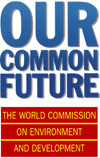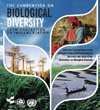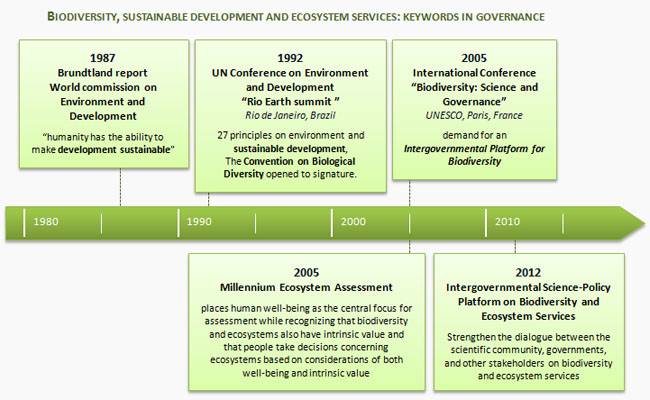1.1.3 Biodiversity, sustainable development and ecosystem services: keywords in governance

Since the 1980s, biodiversity, sustainable development and now ecosystem services have become key words in international governance.
 In 1987, the World Commission on Environment and Development answers a call from the General Assembly of the United Nations to propose “long-term environmental strategies for achieving sustainable development by the year 2000 and beyond” [Brundtland report, 1987
In 1987, the World Commission on Environment and Development answers a call from the General Assembly of the United Nations to propose “long-term environmental strategies for achieving sustainable development by the year 2000 and beyond” [Brundtland report, 1987 ].
].
In 1988, the United Nations Environment Programme (UNEP) explored the need for an international convention on biological diversity. The Convention on Biological Diversity was open to signature in 1992 at the United Nations Conference on Environment and Development (the Rio "Earth Summit").
In 2005, following the International Conference “Biodiversity: Science and Governance” hosted at the headquarters of UNESCO in Paris, the scientific committee demanded an Intergovernmental Platform for Biodiversity [Maris, 2014; Loreau et al. 2006 ] equivalent to the Intergovernmental Panel on Climate Change(IPCC).
] equivalent to the Intergovernmental Panel on Climate Change(IPCC).
 At the same time, the Ecosystem Services Approach was popularised within the decision-making sphere, by the publication in 2005 of the results of the Millennium Ecosystem Assessment [MEA, 2005
At the same time, the Ecosystem Services Approach was popularised within the decision-making sphere, by the publication in 2005 of the results of the Millennium Ecosystem Assessment [MEA, 2005 ], a study carried out by 1300 scientists from around the world under the umbrella of the United Nations Environment Programme.
], a study carried out by 1300 scientists from around the world under the umbrella of the United Nations Environment Programme.
As a result of the success of the Millennium Ecosystem Assessment, the biodiversity platform was finally launched in 2012 by the United Nations and named the Intergovernmental Science-Policy Platform on Biodiversity and Ecosystem Services (IPBES).

The definition of these three keywords has changed over time and is the object of ongoing debate.
Biodiversity
The variability among living organisms from all sources, including inter alia terrestrial, marine, and other aquatic ecosystems and the ecological complexes of which they are part, this includes diversity within species, between species, and of ecosystems [cf. Article 2 of the Convention on Biological Diversity, 1992, in Maes et al., 2013 ]
]
Sustainable development
is development that meets the needs of the present without compromising the ability of future generations to meet their own needs. It contains within it two key concepts: the concept of needs, in particular the essential needs of the world's poor, to which overriding priority should be given;
the concept of needs, in particular the essential needs of the world's poor, to which overriding priority should be given;
 the idea of limitations imposed by the state of technology and social organization on the environment's ability to meet present and future needs. [Brudtland report, 1987
the idea of limitations imposed by the state of technology and social organization on the environment's ability to meet present and future needs. [Brudtland report, 1987 ]
]
Ecosystem services
a broad term to describe the collective benefits of natural ecosystems to humankind. Ecosystem services can be defined in a variety of ways, including:
- ‘…the benefits human populations derive, directly or indirectly, from ecosystem functions’
- ‘…the benefits people obtain from ecosystems’
- ‘…services provided by the natural environment that benefit people’
- ‘…the direct and indirect contributions of ecosystems to human well-being’
The common emphasis is the beneficial role played by ecosystems in enhancing or maintaining aspects of human well-being and thereby human society e.g. food production, climate regulation, flood protection, pollution sinks, and recreational and aesthetic benefits.

